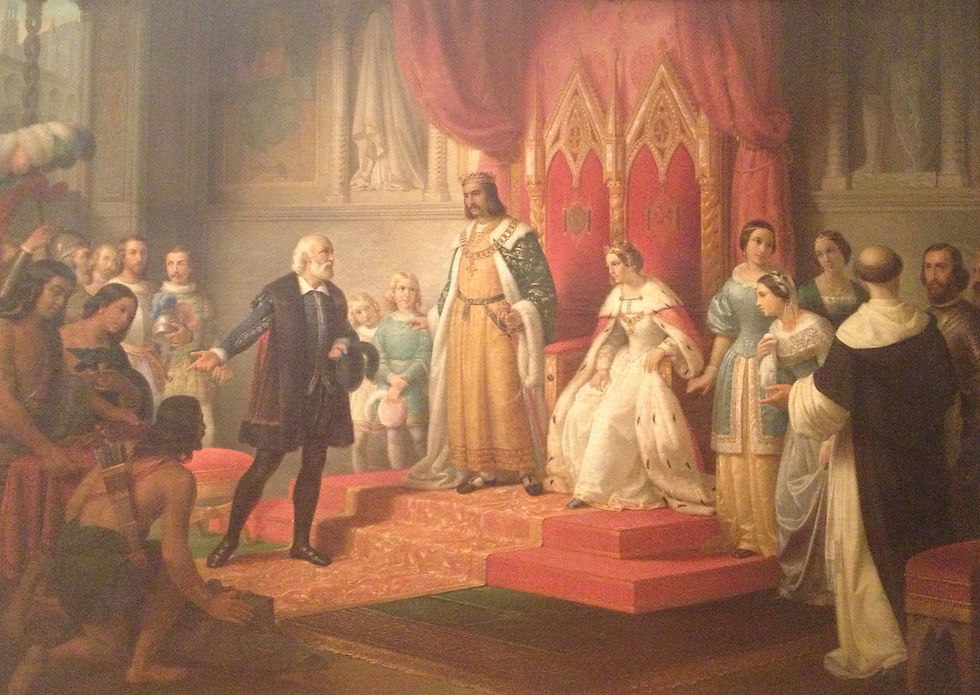Aug 3 Christopher Columbus
- Pearl of Great Price
- Aug 6, 2021
- 3 min read

Today at dawn the Santa María and its companion boats commenced the historic voyage which will bring Europeans to America. The expedition’s leader, Christopher Columbus, always insisted, in the face of mounting evidence to the contrary, that the lands that he visited during those voyages were part of the Asian continent, as previously described by Marco Polo and other travellers (see pod of July 3)
Columbus's refusal to acknowledge that the lands he had visited and claimed for Spain were not part of Asia, might explain, in part, why the American continent was named after the Florentine explorer Amerigo Vespucci—who received credit for recognizing it as a "New World"—and not after Columbus. These voyages marked the beginning of the European exploration and colonization of the Americas, and are thus important to both the Age of Discovery and Western history. He was fascinated by the stories of Brendan
the Navigator (pod of May 16)

His audacious voyage had both missionary and trade ambitions. In order to get financed he had persistently lobbied multiple kingdoms, and finally the Catholic monarchs Queen Isabella I and King Ferdinand II had agreed to sponsor a journey west. He had to wait until Ferdinand and Isabella conquered Granada, the last Muslim stronghold on the Iberian Peninsula, in January 1492. It was touch and go for a time as a council led by Isabella's confessor, Hernando de Talavera, found Columbus's proposal to reach the Indies implausible. Columbus, disappointed had left for France when Ferdinand intervened, first sending Talavera and then a Bishop to appeal to the queen. Isabella then sent a royal guard to fetch Columbus, who had travelled several kilometres toward Córdoba. It was agreed that if he was successful, he had the right to nominate three persons, from whom the sovereigns would choose one, for any office in the new lands. He would be entitled to 10 percent of all the revenues from the new lands in perpetuity.
On the evening of 3 August 1492, Columbus departed from Palos de la Frontera with three ships. The largest was a carrack, the Santa María, owned and captained by Juan de la Cosa, and under Columbus's direct command. The other two were smaller caravels, the Pinta and the Niña and they first sailed to the Canary Islands. There he restocked provisions and made repairs then departed for what turned out to be a five-week voyage across the ocean. On 7 October, the crew spotted an immense flocks of birds and 4 days later, Columbus changed the fleet's course to due west, and sailed through the night, believing land was soon to be found. At around 02:00 the following morning, a lookout on the Pinta spotted land. The captain of the Pinta, verified the sight of land and alerted Columbus. Columbus later maintained that he had already seen a light on the land a few hours earlier, thereby claiming for himself the lifetime pension promised by Ferdinand and Isabella to the first person to sight land. Columbus called this island (in what is now the Bahamas) San Salvador (meaning "Holy Saviour")

Christopher Columbus' journal entry of 12 October 1492 states: Many of the men I have seen have scars on their bodies, and when I made signs to them to find out how this happened, they indicated that people from other nearby islands come to San Salvador to capture them; they defend themselves the best they can. I believe that people from the mainland come here to take them as slaves. They ought to make good and skilled servants, for they repeat very quickly whatever we say to them. I think they can very easily be made Christians, for they seem to have no religion. If it pleases our Lord, I will take six of them to Your Highnesses when I depart, in order that they may learn our language.
He noted that their primitive weapons and military tactics made the natives susceptible to easy conquest, writing, "these people are very simple in war-like matters ... I could conquer the whole of them with 50 men, and govern them as I pleased." They went on to explore the northeast coast of Cuba, and the Santa María ran aground on Christmas Day 1492 and had to be abandoned. Columbus left 39 men, including the interpreter Luis de Torres and founded the settlement of La Navidad, in present-day Haiti. Their last stop of this voyage in the Americas, in the Bay of Rincón in northeast Hispaniola.[85] There he encountered the warlike Ciguayos, the only natives who offered violent resistance during this voyage. On his return three papal bulls of Pope Alexander VI delivered in 1493 purported to grant overseas territories to Portugal and the Catholic Monarchs of Spain. (see pod of May 4)
.jpg)


Yorumlar